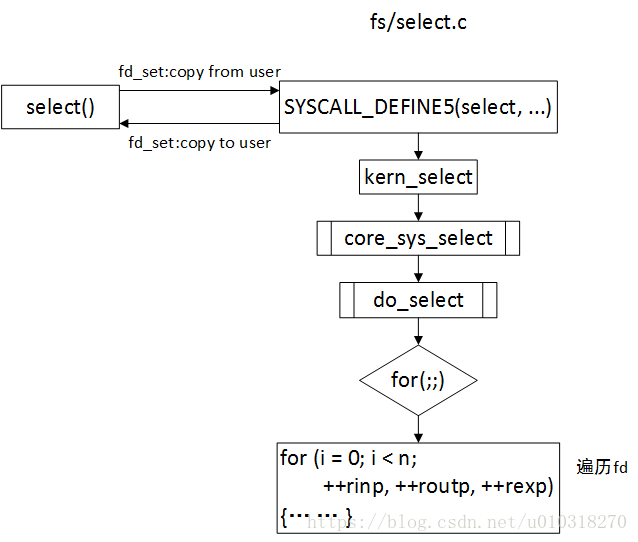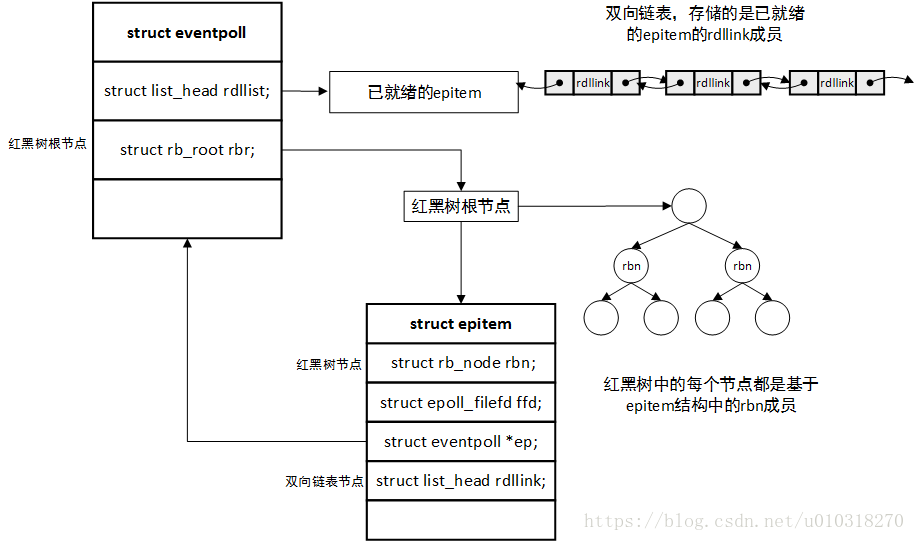一、select
#include <sys/select.h>
#include <sys/time.h>
int select(int nfds, fd_set *readfds, fd_set *writefds, d_set *exceptfds, struct timeval *timeout);
void FD_CLR(int fd, fd_set *set);
int FD_ISSET(int fd, fd_set *set);
void FD_SET(int fd, fd_set *set);
void FD_ZERO(fd_set *set);
// nfds设置成这三个参数中[readfds, writefds, exceptfds] socket描述符句柄中最大值加1
static int do_select(int n, fd_set_bits *fds, struct timespec64 *end_time)
{
// ... ...
poll_initwait(&table); // init_poll_funcptr(&pwq->pt, __pollwait); 注册回调函数
for (;;) {
// ... ...
for (i = 0; i < n; ++rinp, ++routp, ++rexp) { // 遍历所有fd
// ... ...
f = fdget(i);
if (f.file) {
if (f_op->poll) { // 调用对应的poll方法
// 对每个fd进行I/O事件检测
mask = (*f_op->poll)(f.file, wait); // 返回一个描述读写操作是否就绪的mask掩码
}
fdput(f);
// 根据mask掩码判断是否有就绪的fd
if ((mask & POLLIN_SET) && (in & bit)) {
retval++;
}
if ((mask & POLLOUT_SET) && (out & bit)) {
retval++;
}
if ((mask & POLLEX_SET) && (ex & bit)) {
retval++;
}
}
cond_resched(); // 让出CPU给其他进程运行,下次执行时从这里开始
}
// 如果有准备好的fd,或者超时,或者有信号打断,退出循环
if (retval || timed_out || signal_pending(current))
break;
// 当do_select()没有达到上述三种情况时,会让当前进程去休眠一段时间,
// 等待fd设备或定时器来唤醒自己,然后再继续循环看看哪些fd可用,提高效率
if (!poll_schedule_timeout(&table, TASK_INTERRUPTIBLE, to, slack))
timed_out = 1;
}
}步骤:
1、用copy_from_user从用户空间拷贝fd_set到内核空间
2、注册回调函数__pollwait
3、遍历所有fd,调用对应的poll方法(会调用到__pollwait),poll函数返回一个mask掩码,表示读写操作是否就绪。
4、根据mask掩码判断是否有就绪的fd
5、把fd_set从内核空间拷贝到用户空间
缺点:
1、每次调用select,都需要把fd_set集合从用户态拷贝到内核态。(fd很多时开销会很大)
2、每次调用select都需要在内核遍历传进来的所有fd。(fd很多时开销会很大)
3、select支持的文件描述符数量太小,默认是1024。
include/uapi/linux/posix_types.h
#define __FD_SETSIZE 1024二、poll
poll的实现和select机会一样,不同的地方在于把fd_set替换成了pollfd。poll()使用链表保存文件描述符,poll()没有最大文件描述符的限制,但是数量过大后性能也会下降。同时用户态到内核态之间的拷贝问题依然存在。
#include <poll.h>
int poll(struct pollfd *fds, nfds_t nfds, int timeout);
struct pollfd {
int fd; /* file descriptor */
short events; /* requested events */
short revents; /* returned events */
};
// events and revents可能的取值
POLLIN:There is data to read.
POLLPRI:There is urgent data to read (e.g., out-of-band data on TCP socket).
POLLOUT:Writing now will not block.
POLLRDHUP:Stream socket peer closed connection, or shut down writing half of connection.
POLLERR:Error condition (output only).
POLLHUP:Hang up (output only).
POLLNVAL:Invalid request: fd not open (output only).三、epoll
#include <sys/epoll.h>
int epoll_create(int size);
int epoll_ctl(int epfd, int op, int fd, struct epoll_event *event);
int epoll_wait(int epfd, struct epoll_event *events, int maxevents, int timeout);1、epoll_create()
int epoll_create(int size);
// 创建一个epoll的句柄,size用来告诉内核这个监听的数目一共有多大。
// 当创建好epoll句柄后,它就会占用一个fd值。在使用完epoll后,必须调用close()关闭,否则可能导致fd被耗尽。
// 返回值:非负的文件描述符(fd)当进程调用epoll_create()创建一个epoll对象时,内核会创建一个eventpoll结构体。
struct eventpoll {
# ... ...
/* List of ready file descriptors */
struct list_head rdllist; // 双链表中存放着将要通过epoll_wait返回给用户的满足条件的事件
/* RB tree root used to store monitored fd structs */
struct rb_root rbr; // 红黑树根节点,树存储着所有添加到epoll中的需要监控的事件
# ... ...
};在epoll对象中,每一个事件event都会建立一个epitem结构体。
struct epitem {
union {
/* RB tree node links this structure to the eventpoll RB tree */
struct rb_node rbn; // 红黑树节点
// ... ...
};
/* List header used to link this structure to the eventpoll ready list */
struct list_head rdllink; // 双向链表节点
/* The file descriptor information this item refers to */
struct epoll_filefd ffd; // 事件句柄信息
struct eventpoll *ep; // 指向其所属的eventpoll对象
/* The structure that describe the interested events and the source fd */
struct epoll_event event; // 期待发生的事件类型
};2、epoll_ctl()
事件注册函数,当op为EPOLL_CTL_ADD会调用回调函数ep_poll_callback,它会将事件的rdllink添加到rdllist双链表中。
int epoll_ctl(int epfd, int op, int fd, struct epoll_event *event);
// 事件注册函数
// epfd:epoll_create()的返回值
// op:表示动作
EPOLL_CTL_ADD:注册新的fd到epfd;
EPOLL_CTL_MOD:修改已经注册的fd的监听事件;
EPOLL_CTL_DEL:从epfd中删除一个fd;
// fd:需要监听的fd
// event:告诉内核需要监听什么事件
// 返回值:成功返回0typedef union epoll_data {
void *ptr;
int fd;
__uint32_t u32;
__uint64_t u64;
} epoll_data_t;
struct epoll_event {
__uint32_t events; /* Epoll events */
epoll_data_t data; /* User data variable */
};
// events表示对应的文件描述符可以进行的操作
EPOLLIN:可读;
EPOLLOUT:可写;
EPOLLRDHUP:[TODO];
EPOLLPRI:有紧急的数据可读;
EPOLLERR:发生错误;
EPOLLHUP:被挂断;
EPOLLET:将EPOLL设置为边缘触发模式(Edge Triggered);
EPOLLONESHOT:只监听一次事件,当监听完这次事件之后,如果还需要继续监听这个socket,需要再次把这个socket加入到EPOLL队列里。
3、epoll_wait()
只需要检查rdllist是否为空,如果不为空,则把发生的事件复制到用户态,同时将事件数量返回给用户。
int epoll_wait(int epfd, struct epoll_event *events, int maxevents, int timeout);
// 等待事件的产生
// events:从内核得到事件的集合
// maxevents:告诉内核这个events有多大,该值不能大于epoll_create()时的size
// timeout:超时时间,毫秒,0表示立即返回,-1表示不确定也就是永久阻塞
// 返回值:需要处理的fd数目,0表示timeout对于select的三个缺点,epoll都可以避免。
第一个缺点,epoll的解决方案在epoll_ctl函数中,每次注册新的事件到句柄中时(EPOLL_CTL_ADD),会把所有的fd拷贝进内核,而不是在
epoll_wait的时候重复拷贝。epoll保证了每个fd在整个过程中只会拷贝一次。
对于第二个缺点,epoll的解决方案不像select或poll一样每次都把current轮流加入fd对应的设备等待队列中,而只在epoll_ctl时把current挂一遍,
并为每个fd指定一个回调函数。当设备就绪,唤醒等待队列上的等待着时,就会调用这个回调函数,而这个回调函数会把就绪的fd加入一个就绪链表。
epoll_wait的工作实际上就是在这个就绪链表中查看有没有就绪的fd(也会休眠一会,然后再判断)。
4、总结
通过红黑树和双链表数据结构,并结合回调机制,使得epoll高效。
(1)进程调用epoll_create()时,创建一个epoll对象,对应内核创建的一个eventpoll结构体。
(2)调用epoll_ctl()时,如果op为EPOLL_CTL_ADD,向epoll对象中添加事件,这些事件会挂载在红黑树上(rbn)。重复添加的事件就可以通过红黑树高效的识别出来。
(3)所添加到epoll中的事件会与设备驱动程序建立回调关系。也就是说当相应的事件发生时会调用回调函数ep_poll_callback,它会将事件的rdllink添加到rdllist双链表中。
(4)调用epoll_wait()时,检查是否有事件发生时,只需要检查eventpoll对象中的rdllist双链表中是否有epitem元素即可。
如果rdllist不为空,则把发生的事件复制到用户态,同时将事件数量返回给用户。

epoll具体实现:
http://blog.chinaunix.net/uid-28541347-id-4238524.html
https://blog.csdn.net/shenya1314/article/details/73691088
最后
以上就是饱满黑夜最近收集整理的关于select、poll、epoll解析的全部内容,更多相关select、poll、epoll解析内容请搜索靠谱客的其他文章。








发表评论 取消回复